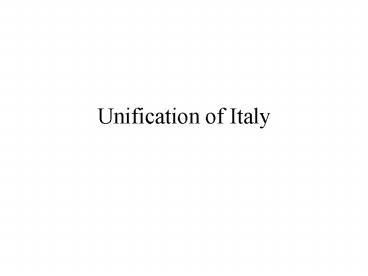Unification of Italy - PowerPoint PPT Presentation
1 / 21
Title:
Unification of Italy
Description:
Italian peninsula was site of frequent wars among countries like ... After Lombardy left Austria, Tuscany, Parma, and Modena wanted to unite with Piedmont, too. ... – PowerPoint PPT presentation
Number of Views:36
Avg rating:3.0/5.0
Title: Unification of Italy
1
Unification of Italy
2
Italy before Unification
- Like Germany, Italy was a collection of
provinces, small kingdoms and city-states since
the Middle Ages. - Italian peninsula was site of frequent wars among
countries like France, Austria, and Spain. - Each wanted to prevent the others from
controlling the areas wealth. - Italian politics was further complicated by the
papal states (states run by the Pope) located in
the center of the peninsula.
3
Italy before Unification
- Under Napoleon I, several Italian states became a
part of his Kingdom of Italy - Short-lived, of course, but gave people a sense
of unity. - Congress of Vienna ignored the desires of
Italians to form their own country. - CoV restored the papal states and gave Austria
control over MUCH of the area.
4
Italy before Unification
- So from early to mid-1800s, Austria ruled much of
Italy and the pope controlled the central area
around Rome.
5
3 major figures in Italian Unification
- Mazzini the soul of Italian unification
- Garibaldi the sword of Italian unification
- Cavour the mind of Italian unification
6
Mazzini
- 1830s Giueseppe Mazzini founded a group called
Young Italy - Young Italy was a secret society dedicated to
founding a united and democratic Italy. - Mazzini stirred up several revoltsmostly
unsuccessful. - M. inspired people with his pamphelets that
promoted unification. - M. ended up fleeing abroad, where he continued to
promote unification.
7
Mazzini
- Mazzinis main idea was that a persons duty to
the nation fits between the duty to ones family
and duty to God.
Duty to God
Duty to Nation
Duty to Family
8
Garibaldi
- Giuseppe Garibaldi worked with Mazzini in the
1830s. - Like M., he fled abroad but came back during the
1848 Revolution in Northern Italy. - Led a revolt against Austria (unsuccessful)
- Garibaldi also tried to replace the rule of the
pope in Rome with a liberal government. - He failed here, too, and had to go into exile.
- But thats not the end of Garibaldi!
9
Cavour
- 1852 Camillo di Cavour came to the fore in
Italian unification, now called Risorgimento
(reawakening)the name of the newspaper he
founded. - Cavour stirred up public opinion in the northern
Italian states against Austrian rule.
10
Cavour
- 1852 King Victor Emmanuel II of Sardinia and
Piedmont made Cavour his prime minister. - Cavour believed in constitutional monarchy
- His plan build up Piedmonts commerce and
industry. This will eventually allow it to win
Italian territory from Austria.
11
Obstacles
- Austria was determined to keep tight control over
northern Italy. - The Pope was against a strong national Italian
government, because that might threaten Church
ownership of the Papal States.
12
Cavours Secret Alliance
- Cavour, meanwhile, made a secret pact with
France. - Then he provoked a war with Austria.
- When Austrian troops invaded Piedmont, French
troops helped the Italians. - The result Piedmont took Lombardy (an old
Austrian possession)
13
Other States Followed!
- After Lombardy left Austria, Tuscany, Parma, and
Modena wanted to unite with Piedmont, too. - Austria gave in, because the French-Italian
alliance meant that Austria would have to face
France in battle.
14
By 1860
- Piedmont controlled all of Italy EXCEPT
- the Kingdom of the Two Sicilies
- The Papal States
- Venice.
- Thats when Garibaldi came back
15
Garibaldis Return
- May 1860 Garibaldi landed in Sicily with an army
of 1000 soldiers dubbed the Red Shirts - The Red Shirts easily won the Kingdom of the Two
Sicilies with the help of Piedmont. - Next, they captured the Papal States except for
Rome. - By March 1861 Victor Emmanuel II became king of
Italy
16
Italy and Prussia
- During the Seven Weeks War (Austro-Prussia War),
Italy helped Prussia against Austria. - The Prussians got Schleswig and Holstein.
- The Italians took Venice (1866)
17
Italy and Prussia, again
- During the Franco-Prussia War, Italian troops
occupied Rome. - Rome was declared the capital of a united Kingdom
of Italy in 1871, just as the North German
Confederation was declared the German Reich.
18
The Transition
19
After Italian Unification
- Unlike Germany, Italy had few natural resources.
- Industry and the economy developed much more
slowly. - Many Italians were poor and illiterate.
20
After Italian Unification
- The Italian constitution
- limited the kings power
- Set up a parliament of elected lawmakers.
- At first only a few wealthy males could vote.
- By 1912 all Italian men could.
- Many poor Italians sold their votes.
- As a result, corruption in government became
widespread.
21
Italy and the Papacy
- Until 1904, the Papacy had still not gotten over
the seizure of the Papal States. - In retaliation, the Papacy forbade Catholics to
vote or to hold office.

